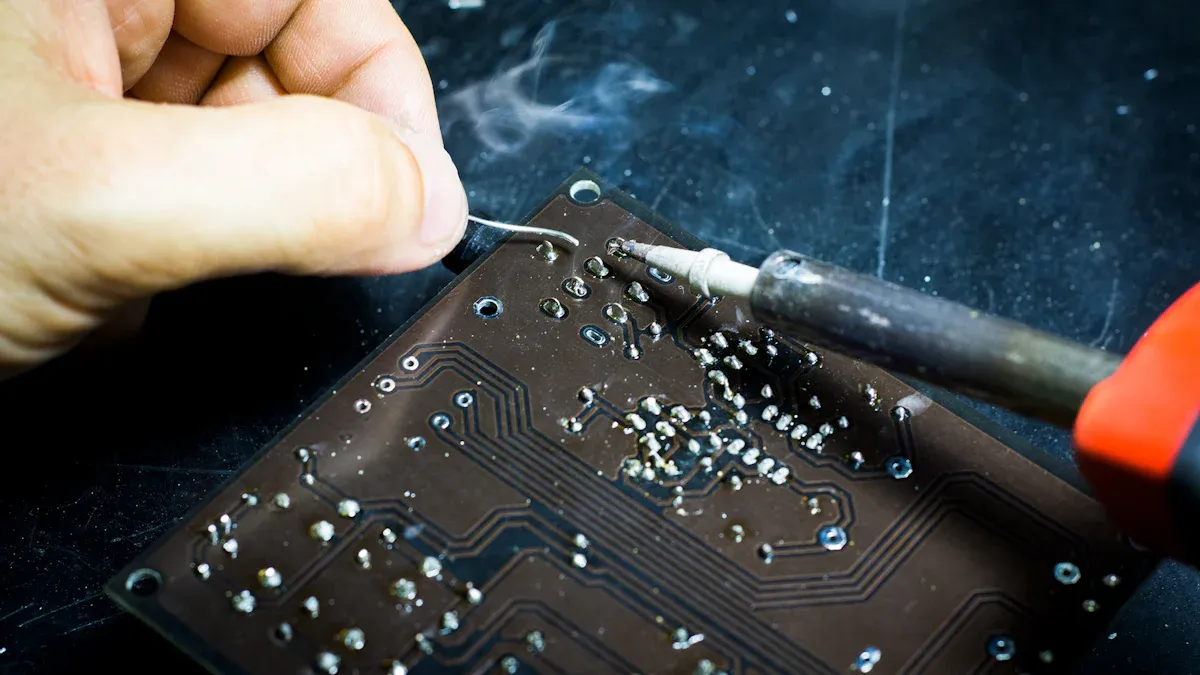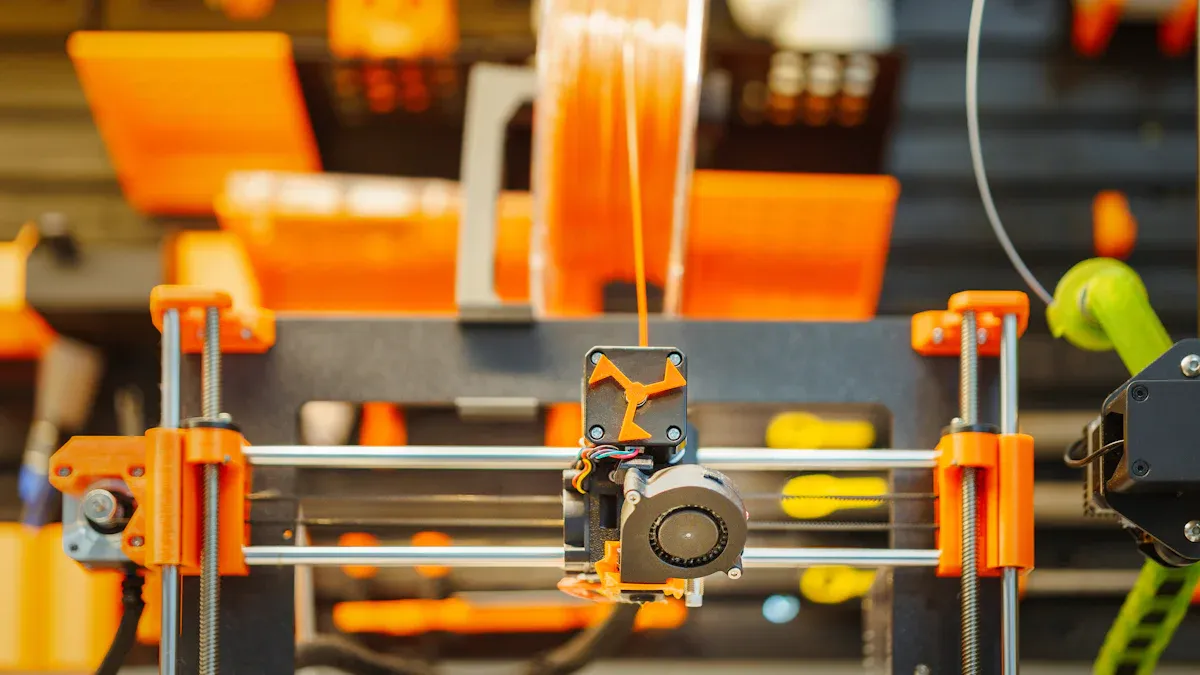
Printed circuit board assembly (PCBA), or what is PCBA, refers to the process of adding components to a bare circuit board. This transformation turns a basic board into a functional electronic device. The PCBA market holds significant importance, valued at $68.4 billion in 2023, with projections to reach $105.8 billion by 2032. The demand for PCBA is primarily driven by gadgets such as smartphones and laptops, which account for 34% of the PCB market. Understanding what is PCBA is essential, as it plays a crucial role in ensuring the technology you rely on daily operates effectively.
Key Takeaways
PCBA changes an empty circuit board into a working device by attaching important parts.
Knowing about PCBA helps make sure electronics like phones and medical tools work well and last long.
Modern PCBA techniques lower costs and speed up production, which is important for car and airplane industries.
What is PCBA? Understanding Printed Circuit Board Assembly

Definition of PCBA
Printed circuit board assembly (PCBA) means adding electronic parts to a circuit board. This process changes a plain board into a working unit for electronics. Rules like IPC-A-610 set quality checks for PCBA. These rules group problems into critical, major, and minor types. This helps makers keep their assemblies reliable and high-quality.
PCBA is very important in today’s electronics. For instance, in laptops, PCBAs link the CPU, GPU, memory, and storage. This makes the laptop work smoothly. Devices like the Dell XPS 15 show how PCBA connects powerful parts like Intel Core i7 chips and NVIDIA GPUs.
Components of a PCBA
A PCBA has key parts that make electronics work. These include:
Resistors and capacitors: Control electricity and store energy.
Microcontrollers and processors: Work as the device’s brain, handling tasks.
Connectors and sockets: Link to other devices.
Sensors: Help devices sense things, like movement in fitness trackers.
In gadgets like the Fitbit Charge 4, small PCBAs combine sensors, controllers, and communication tools in tiny spaces.
The role of the PCB in PCBA
The printed circuit board (PCB) is the base for PCBA. It holds and connects all the parts. Copper lines on the PCB carry electricity, and a solder mask stops short circuits. Labels on the board help place parts correctly during assembly.
The PCB makes sure all parts work well together. For example, in medical tools like MRI machines, the PCB helps send and process data accurately. Without the PCB, the assembly would lack structure and proper connections.
PCBA vs PCB: Key Differences
What is a PCB?
A printed circuit board (PCB) is the base of electronics. It has layers of copper and insulating materials. Copper lines, called traces, connect electronic parts. PCBs also hold parts in place for support.
PCBs are used in many fields like telecom, healthcare, and defense. They are strong and reliable, making them vital for advanced devices. For example, in a smartphone, the PCB links the processor, memory, and other parts. This connection helps the phone work smoothly.
How PCBA builds on a PCB
The PCBA process turns a plain PCB into a working device. Steps include adding solder paste, placing parts, soldering, and checking quality. Each step ensures the product works well and lasts long.
For example, in a laptop, PCBA adds the CPU, GPU, and memory to the PCB. This process allows the laptop to handle tasks quickly. Without PCBA, the PCB would just be an empty board.
Differences between PCB and PCBA
The table below shows how PCB and PCBA differ:
Aspect | PCB (Printed Circuit Board) | PCBA (Printed Circuit Board Assembly) |
|---|---|---|
Definition | Empty board with copper lines. | Board with parts added and tested. |
Function | Offers support and connects parts. | Makes devices work by adding functions. |
Components | None, just a blank board. | Has all needed electronic parts. |
Manufacturing | Made by designing and building the board. | Made by adding, soldering, and testing parts. |
Applications | Used for testing and designing circuits. | Found in gadgets like phones and laptops. |
This table shows how PCBA improves a PCB. A PCB is just the base, while PCBA adds parts to make it work.
PCBA Assembly Methods
Surface Mount Technology (SMT)
Surface Mount Technology (SMT) is a common way to assemble PCBAs. It places parts directly on the circuit board’s surface. This method is fast and helps make smaller devices. In 2023, the SMT market was worth $5,271.9 million. It is growing by 5.8% yearly until 2030. This shows the rising need for tiny, compact gadgets.
SMT is reliable and efficient, so many use it. Knowing this process can save money and keep products working well. SMT works best for making many items quickly with few mistakes.
Thru-Hole Technology
Thru-Hole Technology (THT) puts part leads through PCB holes. These leads are soldered on the other side of the board. This method makes strong bonds, good for tough conditions or stress. THT parts are bigger, so they’re easier to use in testing.
THT is often used in cars, factories, and medical tools. For example, it keeps car safety systems and power circuits dependable. THT also works well in high-frequency uses and handles heat better. Its strong soldering makes it last a long time.
Hybrid Assembly Methods
Hybrid assembly mixes SMT and THT to use their best features. This mix gives more design options and better PCBA functions. Makers use hybrid methods for complex electronic needs.
By combining these methods, you can make boards for many uses. Hybrid assembly is popular because it supports advanced designs and stays efficient. It’s great for industries needing small but tough devices, like aerospace and telecom.
Benefits of Printed Circuit Board Assembly
Compact and efficient design
PCBA helps make small and efficient electronic devices. By adding parts directly to the PCB, makers can shrink device sizes. This is very useful for gadgets like smartphones and smartwatches, where space is tight.
Smaller designs also work better. For example, cutting PCB size by 35% lowers power loss and boosts reliability. Devices with PCBA use less power, making batteries last longer by days. The process also protects parts from water and extreme heat, making them durable.
Performance Metric | Statistic |
|---|---|
Space savings | |
Improved performance | Less power loss, more reliable |
Power efficiency | Batteries last several days longer |
Durability | Protected from water and heat |
High reliability and durability
PCBA makes devices strong and dependable. Makers test products to see how well they last over time. Tests like HALT and HAST copy real-world conditions to find weak spots.
Important tests check:
How well it handles shaking.
If it works in heat and humidity.
How long it lasts after many test cycles.
The bathtub curve shows failure rates drop after early testing. Devices with PCBA stay reliable for a long time. This makes them great for tough jobs like in cars or airplanes.
Cost-effectiveness in mass production
PCBA saves money when making many products. Modern PCBA methods are flexible and meet market needs quickly. Old ways cost more due to poor quality and outdated tools.
Using advanced PCBA lowers costs and speeds up production. For example, an auto parts company made testing six times faster. A global electronics maker improved testing four times faster. These examples show PCBA keeps quality high while saving money.
Case Study | Benefit Description |
|---|---|
Automotive ADAS PCBA Testing | |
Auto Parts Maker | Testing became six times faster. |
Global Electronics Manufacturer | Testing sped up four times, saving money. |
Applications of PCBA

Consumer electronics
PCBA is important for making consumer electronics work well. Devices like phones, cameras, and computers need PCBs to connect parts. The rise of 5G, IoT, and AI has increased PCBA use in this field.
For example, companies have solved problems using advanced PCBA methods.
Company | Problem | Solution | Outcome |
|---|---|---|---|
Company A | Time-consuming assembly | Automated systems | Faster assembly, better accuracy |
Company B | Poor quality control | AI inspection tools | Fewer errors, more reliable products |
Company C | Environmental concerns | Green materials | Less harm to the environment |
These examples show how PCBA improves speed, quality, and eco-friendliness in electronics.
Automotive industry
Cars today rely on PCBA for their smart systems. These include safety features, entertainment systems, and engine controls.
Safety systems like lane warnings need PCBs to work correctly.
Entertainment systems use PCBs for handling complex tasks.
Engine controls depend on strong PCBs for safety and emissions rules.
Electric and self-driving cars need advanced PCBs with many layers. These help cars stay safe, efficient, and connected.
Medical devices
PCBA is key for medical devices to work safely and precisely. Machines like MRI scanners, pacemakers, and pumps need PCBs to function well. Rules like ISO 13485:2016 and FDA guidelines ensure these devices are safe.
Important needs for medical PCBA include:
Tracking each part with unique IDs.
Proof of materials and their sources.
Records of processes and quality checks.
These steps make sure medical devices meet strict safety and performance rules.
Industrial and aerospace applications
Industries like aerospace and defense need strong PCBs for critical tasks. These PCBs must handle tough conditions and still work well.
In planes, PCBs are used for controls, communication, and navigation.
Defense systems need durable PCBs for safety and efficiency.
PCBA helps these industries achieve high performance, making it essential for their success.
PCBA, or printed circuit board assembly, changes a plain PCB into a working electronic system. It is crucial for modern devices in many industries.
The global PCBA market grows 6-8% yearly. This growth comes from higher demand in cars, telecom, and healthcare.
In aerospace, light PCBAs handle tough conditions. Medical devices use special sensors for wearables.
Learn about PCBA to create and keep up with new technology.
FAQ
What is the difference between SMT and THT in PCBA?
SMT puts parts on the PCB’s surface. THT pushes part leads through holes. SMT is great for small gadgets. THT works well in tough environments.
Can you reuse a PCB after removing components?
Yes, a PCB can be reused if it’s not damaged. Clean it well and check it carefully before using it again.
How do you ensure PCBA quality?
Makers follow strict rules like IPC-A-610. They use machines to inspect, test functions, and check for stress to ensure good performance.
💡 Tip: Pick a reliable maker to get the best PCBA for your needs.
See Also
Understanding PCBA: Its Importance in Electronic Devices
The Significance of PCBA Services in Electronics Production
Choosing Between PCB and PCBA: Making the Right Decision